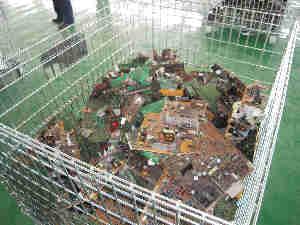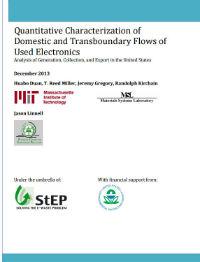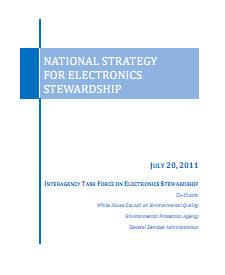Cleaning Up Electronic Waste (E-Waste)
EPA also collaborates with the Solving the E-waste Problem Initiative (Step) Exit to jointly address the e-waste problem in developing countries. Step, formerly known as UNU-Step, was previously an initiative under the United Nations University (UNU). EPA and UNU first signed a cooperative agreement to work together on e-waste in November 2010 and then again in 2015. Some of the work undertaken by UNU-Step included tracking global flows of e-waste, the Person-in-the-Port project in Nigeria, optimization of an e-waste dismantling facility in Ethiopia and the development of a tool to help gather information on volumes of e-waste generated within countries and exported to others. EPA is a founding member of the Step Initiative and serves on the Step Supervisory Committee.
Highlights
March 2019: EPA participated in the launch of the UNIDO-GEF project, “Strengthening of National Initiatives and Enhancement of Regional Cooperation or the Environmentally Sound Management of POPs in Waste of Electronic of Electrical Equipment (WEEE).” With EPA’s support, Step developed a tool which will enhance the ability of participating countries to assess how much e-waste is generated, imported and exported.
The meeting took place in San Jose, Costa Rica with participation from the thirteen countries involved in the project, along with experts from around the region and the world.
Understanding E-Waste
What is E-Waste?

Understanding the Problem
National Strategy for Electronics Stewardship
Capacity Building
Building Capacity in Developing Countries and Sharing Best Practices
Ethiopia:
Managing the e-waste created by an increasing amount of computer and telecommunication equipment is important to the Ethiopian government, and many international partners have worked in Ethiopia to help address this concern.
In 2010, EPA provided funds to the United Nations University (UNU) to assess e-waste in Ethiopia. The assessment was carried out by Germany’s Oeko Institute. Based on the results, the Global Environment Facility (GEF) invested $1 million in a project to strengthen Ethiopia’s capacity to manage e-waste. This was the GEF’s first investment on the e-waste issue. The EPA and GEF projects build upon a previous World Bank-funded initiative aimed at enhancing Ethiopia’s Information and Communication Technology (ICT) sector.
Through this multiyear effort, EPA, UNU-Solving the E-waste Problem (StEP ) and the GEF assessed the state of e-waste in Ethiopia, studied national and international downstream markets for certain e-waste components, and identified financing models for sound e-waste management in Ethiopia. The project also strengthened the capacity of a demanufacturing facility to process e-waste in Addis Ababa.
The United Nations Industrial Development Organization (UNIDO) was the overall manager of the GEF project, with UNU-StEP’s Initiative team serving as the technical experts. EPA served as an international advisor to an Ethiopian working group on e-waste management during the course of this work. The project ended in late 2016.
These efforts developed the following publications:
The following links exit the site Exit
- Solving the E-Waste Problem (StEP) Green Paper: E-waste Country Study Ethiopia (PDF) (46 pp, 1.85M, About PDF)
- National and International Downstream Markets for DMF E-waste Dismantling Fractions – Metals, Printed Circuit Boards and Plastics: E-Waste Management Project in Ethiopia (PDF) (84 pp, 2.67M, About PDF)
- Financing Models for Sound E-waste Management in Ethiopia (PDF) (99 pp, 2.48M, About PDF)
International E-Waste Management Network:
The International E-Waste Management Network (IEMN) is a network of government officials that come together annually to exchange best practices and learn from experts how to improve management of used electronics in their own countries. US EPA and the Taiwan Environmental Protection Administration (EPAT) support this effort through a cooperative agreement.
The IEMN began in 2011 and held its 6th annual workshop in October 2016 in Kuala Lumpur, Malaysia. Officials from the governments of Asia, Africa, Latin America, the Caribbean and North America were present to learn and share about new tools and approaches to e-waste management.
Multilateral Cooperation
Additional Links
You can learn more about EPA's work on e-waste and used electronics management at the following links:
- Sustainable Management of Electronics
- National Strategy for Electronics Stewardship (NSES)
- CEC report: “Quantitative Characterization of Domestic and Transboundary Flows of Used Electronics Products,” (128 pp, 3 M, About PDF)EXIT detailing trade flows of used electronics from and within North America.
Contacts
U.S. Environmental Protection Agency
Office of International and Tribal Affairs (2670R)
1200 Pennsylvania Ave., NW
Washington, DC 20460


